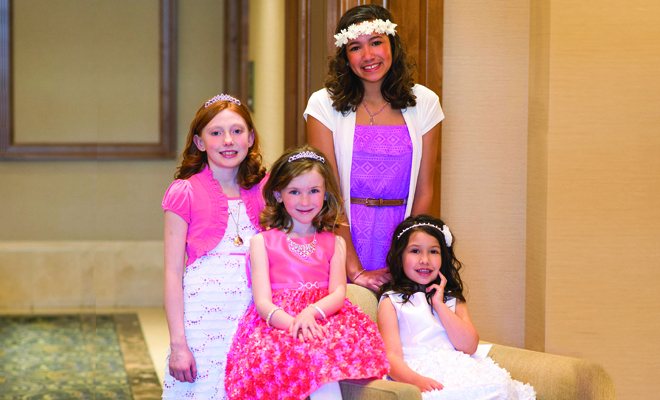 Alex Garza of Garza's Photography
Alex Garza of Garza's Photography
Who is influencing your daughters view on Beauty?
Skyrocketing suicide rates, crippling depression and debilitating eating disorders. Child abuse, violence and even human trafficking. These are not merely headlines ripped from the pages of a newspaper, but are among the serious issues facing our young girls today. For youth between the ages of 10 and 24, suicide is the second leading cause of death, according to the Centers for Disease Control and Prevention. Nearly 4,600 lives–lives with budding potential–are lost each year. Less than two years ago, KTVB reported a disturbing new trend in child abuse right here in Idaho. Abuse, neglect and abandonment are on the rise, but, as the trend shows, the severity of the calls has increased. In fact, there was a nine percent increase in emergency and life-threatening incidents statewide. The National Institute of Mental Health estimates that eating disorders affect more than five million Americans each year, with disorders usually starting in the teen years or as young as age eight.
What’s the connection? All of these major issues have their roots planted deep in self-confidence and self-worth. But with the rise of social media and the continuing presence of television, movies and the Internet, the real question is: Who is influencing what your daughter thinks “beautiful” means?
Beauty can be defined as “the quality present in a thing or person that gives intense pleasure or deep satisfaction to the mind, whether arising from sensory manifestations such as shape, color, sound, a meaningful design or pattern, or something else such as a personality in which high spiritual qualities are manifest.” So it makes sense that a pleasant personality factors strongly into what beautiful means. But how do our young daughters really feel the attributes of confidence and self-worth concur with this description?
The “selfie generation,” as today’s teens and tweens have been nicknamed, are constantly bombarded with unhealthy images. Even without the evidence of surveys or polls, common sense indicates that what girls see factors into their self-esteem. According to a recent Newsweek poll, 77 percent of Americans believe that celebrities and movie stars have too much influence on our young girls. This effect is most evident in their selfconcept, body image and overall outlook on beauty. One poll participant, a first-grade teacher, even noticed her students using derogatory language, singing suggestive song lyrics, and flirting with each other, according to a Teenink.com article.
With celebrities flaunting impossible beauty standards, more young girls are left feeling less confident, more angry, and more dissatisfied
with their looks, reports the National Institute on Media and the Family. In the same group’s 2002 report “Body Image and Gender Identity,” 40 percent of nine- and ten-year-olds had tried losing weight; at age 13, 53 percent of girls were unhappy with their appearance. Six of ten teenage girls think they’d “be happier if they were thinner.” A 2004 Bliss Magazine survey found that while only 19 percent of teenage girls are overweight, 67 percent think they need to lose weight. These are alarming statistics for parents of young girls who are trying to instill self-esteem and confidence in their children.
While the role of the media in girls’ body image is strong, it’s not the only influence. With celebrities becoming increasingly thinner, the average girl’s self-confidence is diminished as she compares herself with what she sees. Images of movie stars or supermodels have been linked to body displeasure, the National Institute on Media and the Family asserted, noting that stars need to be concerned about their image because of the cold, hard truth that it causes young fans to struggle to be unhealthily thin. Celebs should stay at a safe weight to ensure their health and to minimize the effect their weight has in influencing their younger audiences.
Sometimes it’s hard to tell if normal teenage angst is just that, or if it is more in line with depression. About 11 percent of adolescents have a depressive disorder by age 18, according to the National Institutes of Health. Furthermore, girls are more likely than boys to experience depression. Studies show teens with untreated depression are at higher risk for suicide, substance abuse, sexual promiscuity, relationship troubles, school problems and physical illnesses.
More young people die from suicide than from cancer, heart disease, birth defects, pneumonia, influenza and chronic lung disease combined! The American Academy of Pediatrics identifies the long-term impact of child abuse as the leading cause of attempted suicide by women. Stress, insecurities, financial problems, family breakups, unwanted pregnancies and physical and sexual abuse are also among the chief causes for teen suicides. Many young girls who don’t have a strong parental and family support system in place have an even
greater risk of suicide.
How can we, as parents, pastors, teachers and community advocates, help our young girls foster a better, more realistic self-image?
What, if anything, can be done to undo the damage and halt the swelling statistics?
When asked who is really influencing what our daughters believe beautiful means, Dana Griffin quickly replied, “Everyone who shouldn’t be.” As a school psychologist and director of curriculum and professional development for StandBEAUTIFUL, a program created by Derrick Boles, founder of Stand Up America, she is understandably concerned about the issue of self-worth. StandBEAUTIFUL is a youth program designed for young girls to help develop healthier forms of self-esteem and a positive self-concept through the use of a specially designed curriculum titled “I Am A 10.” The innovative material is named after its ten character-building principles and focuses on character development, building beautiful from the inside out.
“We can’t always change a young girl’s immediate environment, their support system or their home life, so instead the program focuses
on building up the individual child,” Dana elaborated. “StandBEAUTIFUL teaches young girls that ‘beautiful’ comes from within–that confidence is beautiful, that intelligence is beautiful, and that authenticity is beautiful. The program focuses on developing a young girl’s mind, spirit and inner talents rather than focusing on physical beauty.
“The statistics across the country are alarming. Suicide is so relevant. Teenage pregnancy, self-injurious behaviors like cutting and girl-on-girl violence are on the rise. We used to focus on middle school and high school age girls, but the reality is low self-esteem starts much earlier; it really begins in elementary school,” continued Dana, who currently provides psychological services to local school districts and community charter schools as a psychologist in addition to her work with StandBEAUTIFUL.
Born and raised in Pocatello, Idaho, Dana holds an undergraduate degree in psychology from Idaho State University and a graduate degree in psychology from Houston Baptist University. Sadly, she is all too familiar with the difficult issues facing young girls today. The increase in these issues, she feels, is influenced by the rampant role of social media and the entertainment industry’s influence in our children’s lives.
“Social media can be a positive social outlet for our young people, but it can also be destructive. Our girls are exposed to literally thousands of unhealthy images on a daily basis. These images and messages often portray girls and women as objects, encourage promiscuity, and continually push the boundaries just to generate likes and retweets. If a young girl posts an innocent selfie and only gets a few favorites or likes, her self-esteem is affected. If she shows a little more skin and poses more provocatively, the likes and favorites increase, which in turn has a positive effect on her self-esteem. This trend is sending the wrong message and creates an unhealthy foundation for self-esteem,” remarked Dana, whose passion for working with young girls is evident in her voice as she quotes more alarming numbers. “Forty-two percent of young girls between first and third grade are already reporting wanting to be thinner. And seven of ten young girls report not feeling good enough or measuring up in some way, including their looks, school performance, and in their relationships with friends and family.” These issues cross socioeconomic status and affect young girls in middle class and affluent families, she noted, and are widespread across our country. In fact, StandBEAUTIFUL’s program can be found throughout the country, including Idaho. One local school has expressed the need to bring the program to their cheerleading squad due to bullying problems.
Even more disturbing is the increase of girl-on-girl violence. Every middle school and high school administrator that Dana has met with recently is concerned with this new trend. “Schools are seeing a significant increase in girl-on-girl violence and bullying. Videos of girls taunting, degrading and physically attacking one another have gone viral. They are shared amongst the teens and are often missed by administrators. This ‘bad girl’ image has been mistakenly identified as confidence,” stated Dana. In opposition to this disturbing trend, StandBEAUTIFUL encourages collaboration and stresses the importance of building healthy and productive relationships. How do we combat this epidemic? A few suggestions from leading experts and authors in this field follow. Limit your daughter’s exposure to the media and popular culture when she is young. “Monitoring your child’s social media exposure can sometimes be difficult, due to their exposure to the Internet, so parents should focus on being aware and having open and honest conversations with their daughters about the content they are being exposed to. Parents should also explain that all tweets, pictures, videos and comments on social media sites create a digital footprint, and even when deleted they’re never truly erased. It is not uncommon for prospective colleges and future employers to search social media sites for an inside look into a young person’s character. In effect, it may not just be their self-esteem that takes a hit; their reputation is also at stake,” says Dana. Diane Levin, PhD, author of So Sexy So Soon, adds, “This will give her more time to develop her own ideas, creativity and imagination from her direct first-hand experience. As she grows, media messages will start to get in, so having rules and routines from the start can help your daughter control her own experiences as she gets older.”
Additionally, help her process the messages in the media. “Help her avoid the narrow focus on appearance and consumerism that often dominates the media. By helping your daughter process the messages she sees on the screen and develop her own ideas about them, you can prepare her to better resist the media’s pervasive stereotypes,” says Levin. “Help her notice the bigger picture; for example, point out how looking like her latest teen idol can be fun but also connects her with a lot of other stuff she might not have noticed or thought about,” adds Lyn Mikel Brown, EdD, and Sharon Lamb, EdD, coauthors of the book Packaging Girlhood.
Experts recommend that parents give their girls a voice in making decisions to increase self-confidence. “Whenever possible, let her make
constructive choices about her life. Let her choose her own clothes, within appropriate limits. Give her a voice in what after-school activities she participates in and how many she wants to do, as long as it works for the rest of the family, too. Remember that knowing what she cares about most will come from trying some things and finding she doesn’t like them, as well as from finding things she loves to do,” recommends Jane Katch, EdD, author of They Don’t Like Me. “Your daughter might need to make a commitment for a short time for an activity (one soccer season) but when that’s over, it’s okay to try something different!” Parents should teach their daughter that only she can define who she is. This lesson goes hand in hand with teaching her the power that’s found in defining these things for herself. Encourage your girl to stand in them, be proud of them, nurture them, love them, and ultimately to share them with the world.
Allowing your daughter to disagree with you and get angry is another way to have open, honest dialogue with your child. “Raising a powerful girl means living with one. She must be able to stand up to you and be heard so she can learn to do the same with classmates, teachers, a boyfriend, or future bosses,” says Meg White, MA. In Packaging Girlhood, Brown and Lamb write, “Girls need guidance about how to stay clear in their disagreements, and they need support for not giving up their convictions to maintain a false harmony. Help girls to make considered choices about how to express their feelings, and to whom.” Catherine Steiner-Adair, EdD, clinical psychologist, author, speaker and consultant, notes, “Not all girls will want to do this, especially shy girls, but you can still help them develop the skills.” A leading expert in child development, education and family relationships, Steiner-Adair is also the author of a popular school-based leadership program for girls.
When you encourage your daughter to solve issues on her own rather than fixing things for her, you boost her self-confidence. “When parents take over, girls don’t develop the coping skills they need to handle situations on their own. Ask your daughter to consider three strategies she might use to deal with a situation, and then ask her about the possible outcomes. Let her decide what she wants to do (within reason). Even if you disagree with her choice, you give your daughter a sense of control over her life and show her that she is responsible for her decisions,” states Rachel Simmons, author of Odd Girl Out. One way to quash the current rise in girl-on-girl violence is to get girls working together. “Girls who work cooperatively in school or who problem solve together do much better in taking large risks or facing challenges. These girls report an incredible sense of accomplishment and feeling of competence, both of which give a huge boost to self-esteem,” said JoAnn Deak, PhD, author of Girls Will Be Girls. “Encourage your daughter to participate in team-building activities or join organizations that rely on teamwork.” While we can’t always do away with all of the outside influences, Beauty can be defined as “the quality present in a thing or person that gives intense pleasure or deep satisfaction to the mind, whether arising from sensory manifestations like shape, color, sound, a meaningful design or pattern, or something else such as a personality in which high spiritual qualities are manifest.” What we can do is help to redefine what beautiful means. We can teach our daughters that beauty and self-worth are truly more than just skin deep. As Oprah Winfrey, herself a sexual abuse survivor who fought her own personal battle of self-worth, said, “Self-esteem means knowing you are the dream.” Teach your daughter that she is valuable and precious. Teach her that she has worth, that she should know it and make sure the world knows it too. Teach her to hold her head up high and to look everyone in the eye, and that she doesn’t need to bend or bow down or subject herself to anyone. Teach her to make good decisions that demonstrate she understands her value. She doesn’t have to sell herself short, or give a piece (or her entire self) up to anyone, especially if they are undeserving. Teach her to be proud of herself, her history, and her own story—all of it.
A few excellent parenting books on raising confident girls include Reviving Ophelia: Saving the Selves of Adolescent Girls by Mary Pipher,
PhD; Chicken Soup for the Teenage School: Teens Talk Middle School by Jack Canfield, Mark Victor Hansen, Madeline Clapps and Valerie Howlett; and The Good Girl Revolution: Young Rebels with Self-Esteem and High Standards by Wendy Shalit. There are a plethora of specific websites with an abundance of helpful, relevant information such as Girl Talk (mygirltalk.org), Girls on the Run (girlsontherun.org), Girls Inc. (girlsinc.org) and RespectRX (respectrx.com).
In addition, there are numerous community and statewide resources, starting with help hotlines staffed by caring, experienced individuals; assistance can start with just a phone call. The Idaho Suicide Prevention Hotline provides crisis intervention, emotional support, problem solving and referrals to local resources for those at risk for suicide, their families and loved ones. The hotline number is 1-800-273-TALK (8255). If you suspect any child is being abused, neglected or abandoned, contact Idaho’s Department of Health and Welfare statewide at 1-855-552-KIDS (5437) or in the Treasure Valley area at 208-334-KIDS (5437). StandBEAUTIFUL’s website is stand-upamerica.com. HLM
Sources: depts.washington.edu, dictionary.com, dove.us, forharriet.com, health.nih.gov, pbs.org, rense.com and teenhelp.com.








